Ace Models 1/48 Rafale M
|
KIT #: |
|
|
PRICE: |
$46.30 from hlj
|
|
DECALS: |
Three options |
|
REVIEWER: |
Tom
Cleaver |
|
NOTES: |
Revell kit repackaged |
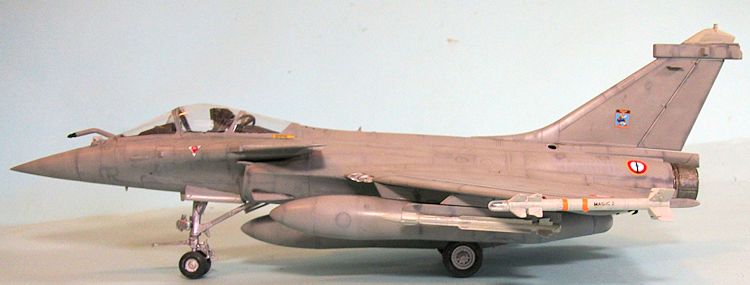
Given my complete lack of knowledge about the Rafale, I
will quote here from Wikipedia:
The Dassault Rafale is a twin‑engine delta‑wing fighter
aircraft designed and built by Dassault Aviation as an omnirole fighter with
semi‑stealth capabilities. The Rafale is a multi-role combat aircraft; capable
of simultaneously undertaking air supremacy, interdiction, reconnaissance, and
airborne nuclear deterrent
 missions.
The Rafale is distinct from other European fighters of its era in that it is
almost entirely built by one country, involving most of France's major defense
contractors, such as Dassault, Thales and Safran.
missions.
The Rafale is distinct from other European fighters of its era in that it is
almost entirely built by one country, involving most of France's major defense
contractors, such as Dassault, Thales and Safran.
In the late 1970s, the French Air Force and Navy were
seeking to replace and consolidate their current fleets of aircraft. In order to
reduce development costs and boost prospective sales, France entered into an
arrangement with four other European nations to produce an agile multi‑purpose
fighter, but subsequent disagreements over work share and differing requirements
led to France's pursuit of its own development program. Dassault built a
technology demonstrator which first flew in July 1986 as part of a eight‑year
flight‑test programme, paving the way for the go ahead of the project.
The Rafale's design and production processes exploits
the unprecedented advancements in software technology; these have enabled the
integration of formerly individual components and combined with automated
analysis processes, known collectively as data fusion. Many of the aircraft's
avionics and features, such as direct voice input (DVI), the RBE2 AA active
electronically scanned array (AESA) radar and the Optronique secteur frontal
(OSF) infra‑red search and track sensor, were indigenously developed and
produced for the Rafale program. Originally scheduled to enter service in 1996,
post‑Cold War budget cuts and changes in priorities contributed to significant
delays.
Introduced in 2001, the Rafale is produced for both the
French Air Force and for carrier‑based operations in the French Navy.
In December 2000, the French Naval Aviation (Aéronavale)received
its first two Rafale Ms. The following year, Flottille 17F was re‑activated
prior to the delivery of the sixth Rafale, thus becoming the first squadron to
operate the type; the squadron had previously operated the F‑8 Crusader.[Flottille
17F immediately participated in Trident d'Or aboard the aircraft carrier
Charles de Gaulle with warships from
ten other nations. After almost four years of training, the Rafale M was
declared operational with the French Navy in June 2004.
The Rafale M is
fully compatible with US Navy aircraft carriers and some French Navy pilots have
qualified to fly the aircraft from US Navy flight decks. On 4 June 2010, during
an exercise on the USS Harry S. Truman
(CVN‑75), a French Rafale became the first jet fighter of a foreign navy to have
its engine replaced on board an American aircraft carrier.
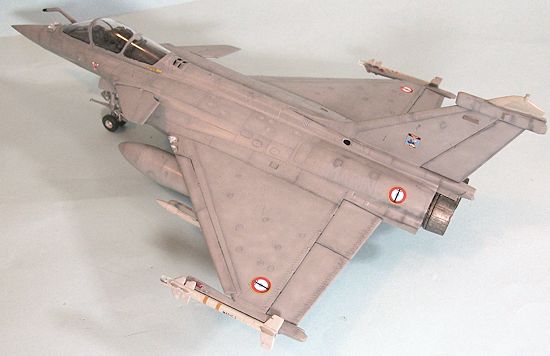 In 2002, the Rafales
were first deployed to a combat zone; seven Rafale Ms embarked aboard the
Charles de Gaulle of during "Mission
Héraclès", the French participation in "Operation Enduring Freedom". They flew
from the aircraft carrier over Afghanistan, but Rafale did not see any action.
In June 2002, while Charles de Gaulle
was in the Arabian Sea, Rafales conducted several patrols near the
India‑Pakistan border.
In 2002, the Rafales
were first deployed to a combat zone; seven Rafale Ms embarked aboard the
Charles de Gaulle of during "Mission
Héraclès", the French participation in "Operation Enduring Freedom". They flew
from the aircraft carrier over Afghanistan, but Rafale did not see any action.
In June 2002, while Charles de Gaulle
was in the Arabian Sea, Rafales conducted several patrols near the
India‑Pakistan border.
In 2007, after a "crash program" enhancement, six
Rafales were given the ability to drop laser‑guided bombs. Three Air Force
aircraft were deployed to Dushanbe in Tajikistan, while the three Rafale-Ms went
on board the Charles De Gaulle. The
first mission occurred on 12 March 2007, and the first GBU‑12 was launched on 28
March in support of embattled Dutch troops in Southern Afghanistan, marking the
operational début of the Rafale. Between January 2009 and December 2011, a
minimum of three Rafales were stationed at Kandahar International Airport to
conduct combat operations in support of NATO ground forces.
On 19 March 2011, French Rafales began conducting
reconnaissance and strike missions over Libya in Opération Harmattan; initial
targets were artillery pieces laying siege around the rebel city of Benghazi.
The Rafale could operate in Libya using the onboard Spectra self‑defense system.
On 24 March 2011, it was reported that a Rafale had destroyed a Libyan Air Force
G‑2/Galeb light attack/trainer aircraft on the runway.
The Rafale would typically conduct six‑hour sorties,
carrying an armament of four MICA air‑to‑air missiles, four or six AASM "Hammer"
bombs, a Thales Damoclès targeting pod and two drop tanks;these patrols required
multiple aerial refueling operations per sortie from coalition tanker
aircraft.The AASM precision‑guidance weapon system, using bombs weighing between
125 kilograms (275.6 lb) and 1,000 kilograms (2,204.6 lb), allowed the Rafale to
conduct high‑altitude bombing missions. Reportedly, Rafale crews preferred to
use GPS‑guided munitions due to greater reliability and range.
 In January 2013, the
Rafale took part in "Opération Serval", the French military intervention in
support to the government of Mali against the Movement for Oneness and Jihad in
West Africa. The first mission was carried out on 13 January, when four Rafales
took off from an airbase in France to strike rebel training camps, depots and
facilities in the city of Gao, eastern Mali. Subsequent air strikes in the
following days by Rafale and Mirage fighters were reportedly instrumental in the
withdrawl of Islamist militant forces from Timbuktu and Douentza. Both Rafale
and Mirage 2000D aircraft used in the conflict have been based outside of North
Africa, making use of aerial refuelling tanker aircraft to fly long range
sorties across Algerian airspace and into Mali.
In January 2013, the
Rafale took part in "Opération Serval", the French military intervention in
support to the government of Mali against the Movement for Oneness and Jihad in
West Africa. The first mission was carried out on 13 January, when four Rafales
took off from an airbase in France to strike rebel training camps, depots and
facilities in the city of Gao, eastern Mali. Subsequent air strikes in the
following days by Rafale and Mirage fighters were reportedly instrumental in the
withdrawl of Islamist militant forces from Timbuktu and Douentza. Both Rafale
and Mirage 2000D aircraft used in the conflict have been based outside of North
Africa, making use of aerial refuelling tanker aircraft to fly long range
sorties across Algerian airspace and into Mali.
This kit from
Ace Ace Corporation/Kawai of Korea is the Revell Rafale kit reboxed, which is
confirmed by the Revell stamp inside the wing. This likely confirms that Ace did
the origina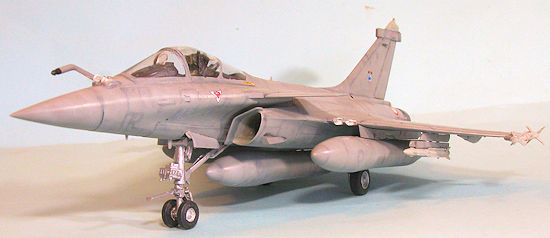 l
production for Revell. What is important is that it has a re‑tooled top fuselage
which has the flare dispensers molded on, which means a current M version can be
built without resorting to aftermarket for the fix.
The only drop tanks included are the large sized ones;
the 4 MICA missiles and 2 MAGIC missiles are included, though the new pylons and
bombs are not included.
Assembly instructions are entirely in Korean, but are
well‑illustrated and easy to follow. Decals provide markings for three aircraft,
though the grey “Marine” and aircraft number decals are not a light enough shade
of grey to stand out properly if one paints the airplane in Sea Grey Medium,
which is the proper color.
l
production for Revell. What is important is that it has a re‑tooled top fuselage
which has the flare dispensers molded on, which means a current M version can be
built without resorting to aftermarket for the fix.
The only drop tanks included are the large sized ones;
the 4 MICA missiles and 2 MAGIC missiles are included, though the new pylons and
bombs are not included.
Assembly instructions are entirely in Korean, but are
well‑illustrated and easy to follow. Decals provide markings for three aircraft,
though the grey “Marine” and aircraft number decals are not a light enough shade
of grey to stand out properly if one paints the airplane in Sea Grey Medium,
which is the proper color.
Overall, the
model is simple.
I understand there is a resin cockpit that was created for the
Revell kit, which would go a long way to improving on the very basic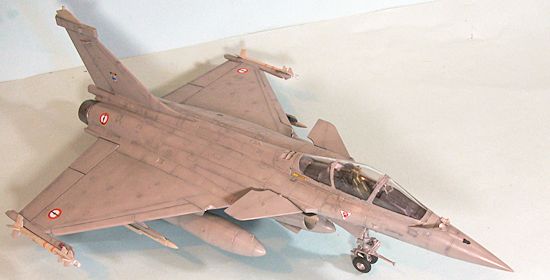 cockpit provided in the kit.
I decided to close the canopy, which is very clear and
allows you to see what is in there without destroying the flowing lines of the
airframe.
cockpit provided in the kit.
I decided to close the canopy, which is very clear and
allows you to see what is in there without destroying the flowing lines of the
airframe.
Overall, fit is excellent, and I only had a gap to fill
with cyanoacrylate glue along the lower wing-fuselage joints.
Other than that, no putty or other filler was required.
I assembled the canard aimed down, which is the position
photos show it in when parked.
Assembly of the main landing gear requires it to be
placed in the wheel wells prior to attaching the wheel well to the lower
fuselage half. This
really wasn't a problem, since I hand-painted the gear leg later.
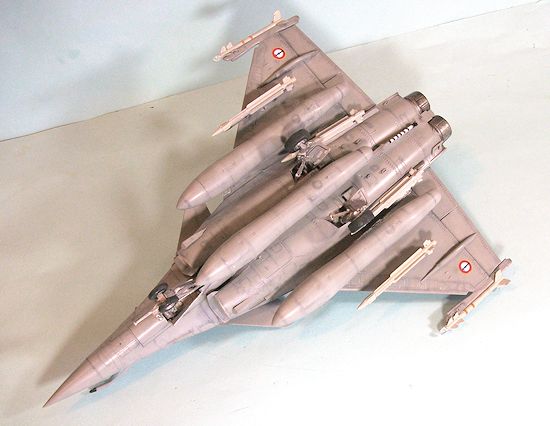 Having found a photo of
Rafales in flight to Mali, that showed the airplanes have a finish that can
become worn like the USN Tactical Paint Scheme, I pre-shaded the model with flat
black along panel lines.
I then gave it an overall coat of Tamiya's new “Sea Grey
Medium”, with Gunze “Light Aircraft Grey” for the wheel wells and intake
trunking.
I lightened the paint and went back over the model blotching it
to get a multi-hue funish.
The six missiles were also painted with “Light Aircraft
Grey.”
Having found a photo of
Rafales in flight to Mali, that showed the airplanes have a finish that can
become worn like the USN Tactical Paint Scheme, I pre-shaded the model with flat
black along panel lines.
I then gave it an overall coat of Tamiya's new “Sea Grey
Medium”, with Gunze “Light Aircraft Grey” for the wheel wells and intake
trunking.
I lightened the paint and went back over the model blotching it
to get a multi-hue funish.
The six missiles were also painted with “Light Aircraft
Grey.”
The decals went on without problem, though as mentioned
above the grey markings were too dark to really give the proper contrast shown
in photos.
I unmasked the
canopy and attached the other clear parts, then attached the nose gear and the
detail parts of the main gear and the wheels.
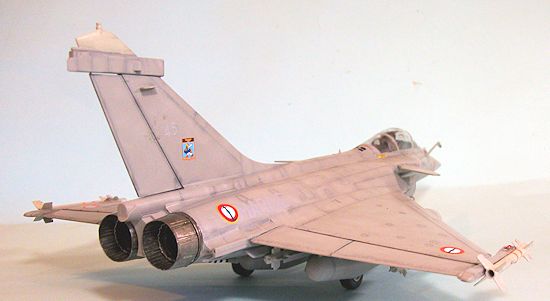 Well, I think this
project confirms my long-held belief that the man who says he can't be bought
has not been offered a sufficient price.
It was fun building this for the client. I quite like
the aesthetics of the Rafale, particularly when compared with the EFA Typhoon
II.
Those modelers who like modern grey jets can have a lot of fun with this
simple, easy to build model.
Well, I think this
project confirms my long-held belief that the man who says he can't be bought
has not been offered a sufficient price.
It was fun building this for the client. I quite like
the aesthetics of the Rafale, particularly when compared with the EFA Typhoon
II.
Those modelers who like modern grey jets can have a lot of fun with this
simple, easy to build model.
Tom Cleaver
February 2013
Copyright ModelingMadness.com. All rights reserved. No reproduction in any part without express permission from the editor.
If you would like your product reviewed fairly and fairly quickly, please contact the editor
or see other details in the
Note to
Contributors.
Back to the Main Page
Back to the Review
Index Page 2025


 missions.
The Rafale is distinct from other European fighters of its era in that it is
almost entirely built by one country, involving most of France's major defense
contractors, such as Dassault, Thales and Safran.
missions.
The Rafale is distinct from other European fighters of its era in that it is
almost entirely built by one country, involving most of France's major defense
contractors, such as Dassault, Thales and Safran. In 2002, the Rafales
were first deployed to a combat zone; seven Rafale Ms embarked aboard the
Charles de Gaulle of during "Mission
Héraclès", the French participation in "Operation Enduring Freedom". They flew
from the aircraft carrier over Afghanistan, but Rafale did not see any action.
In June 2002, while Charles de Gaulle
was in the Arabian Sea, Rafales conducted several patrols near the
India‑Pakistan border.
In 2002, the Rafales
were first deployed to a combat zone; seven Rafale Ms embarked aboard the
Charles de Gaulle of during "Mission
Héraclès", the French participation in "Operation Enduring Freedom". They flew
from the aircraft carrier over Afghanistan, but Rafale did not see any action.
In June 2002, while Charles de Gaulle
was in the Arabian Sea, Rafales conducted several patrols near the
India‑Pakistan border.
 l
production for Revell. What is important is that it has a re‑tooled top fuselage
which has the flare dispensers molded on, which means a current M version can be
built without resorting to aftermarket for the fix.
The only drop tanks included are the large sized ones;
the 4 MICA missiles and 2 MAGIC missiles are included, though the new pylons and
bombs are not included.
Assembly instructions are entirely in Korean, but are
well‑illustrated and easy to follow. Decals provide markings for three aircraft,
though the grey “Marine” and aircraft number decals are not a light enough shade
of grey to stand out properly if one paints the airplane in Sea Grey Medium,
which is the proper color.
l
production for Revell. What is important is that it has a re‑tooled top fuselage
which has the flare dispensers molded on, which means a current M version can be
built without resorting to aftermarket for the fix.
The only drop tanks included are the large sized ones;
the 4 MICA missiles and 2 MAGIC missiles are included, though the new pylons and
bombs are not included.
Assembly instructions are entirely in Korean, but are
well‑illustrated and easy to follow. Decals provide markings for three aircraft,
though the grey “Marine” and aircraft number decals are not a light enough shade
of grey to stand out properly if one paints the airplane in Sea Grey Medium,
which is the proper color. cockpit provided in the kit.
I decided to close the canopy, which is very clear and
allows you to see what is in there without destroying the flowing lines of the
airframe.
cockpit provided in the kit.
I decided to close the canopy, which is very clear and
allows you to see what is in there without destroying the flowing lines of the
airframe. Having found a photo of
Rafales in flight to Mali, that showed the airplanes have a finish that can
become worn like the USN Tactical Paint Scheme, I pre-shaded the model with flat
black along panel lines.
I then gave it an overall coat of Tamiya's new “Sea Grey
Medium”, with Gunze “Light Aircraft Grey” for the wheel wells and intake
trunking.
I lightened the paint and went back over the model blotching it
to get a multi-hue funish.
The six missiles were also painted with “Light Aircraft
Grey.”
Having found a photo of
Rafales in flight to Mali, that showed the airplanes have a finish that can
become worn like the USN Tactical Paint Scheme, I pre-shaded the model with flat
black along panel lines.
I then gave it an overall coat of Tamiya's new “Sea Grey
Medium”, with Gunze “Light Aircraft Grey” for the wheel wells and intake
trunking.
I lightened the paint and went back over the model blotching it
to get a multi-hue funish.
The six missiles were also painted with “Light Aircraft
Grey.”  Well, I think this
project confirms my long-held belief that the man who says he can't be bought
has not been offered a sufficient price.
It was fun building this for the client. I quite like
the aesthetics of the Rafale, particularly when compared with the EFA Typhoon
II.
Those modelers who like modern grey jets can have a lot of fun with this
simple, easy to build model.
Well, I think this
project confirms my long-held belief that the man who says he can't be bought
has not been offered a sufficient price.
It was fun building this for the client. I quite like
the aesthetics of the Rafale, particularly when compared with the EFA Typhoon
II.
Those modelers who like modern grey jets can have a lot of fun with this
simple, easy to build model.